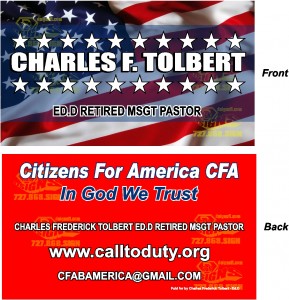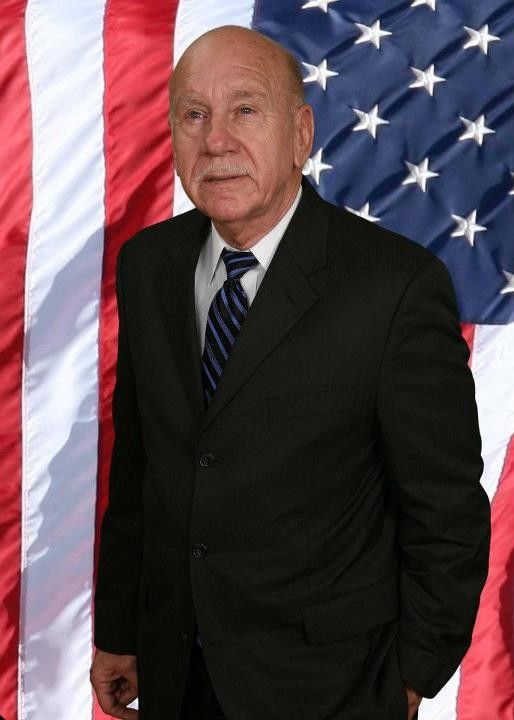The question is why does the press only talk about democrats and Republicans?
When you vote in the 2016 election for the president or United State senate, ask yourself three questions: Did the candidate serve our country and risk his/her life to protect our freedom? Does the candidate have an education concerning how to teach the children of tomorrow? Does the candidate represent the views of 92% of Americans that believe in God? Charles Frederick Tolbert EdD, pastor, retired MSGT and Vietnam veteran For US Senate Florida Citizens for A Better America (CFABA) Www.cfabamerica.com
In the constitution there are to be nine members in the Supreme Court. If we do not elect a new one, according to the constitution, there would be a tie vote.
With the announcement of President Obama’s next Supreme Court justice nominee looming, attention has focused on how the newest addition will affect the balance of the court’s voting. The ninth justice may be the swing vote in future court cases.
In order to prevent President Obama, who should be impeached, (as what took place with President Andrew Johnson) from naming any new Supreme Court justices, the Congress has a right not to approve. Past history of our current Congress has been to approve all of the federal judges Obama has nominated.
When there is a vacancy on the Supreme Court, the president nominates someone who then has to be approved by a majority vote in the Senate.
“If the Court divides 4-4, the lower court opinion is affirmed without creating any Supreme Court precedent,” said Jeffrey Fisher, a professor of law at Stanford University. Since these lower courts are already Obama’s nominees, it would be best to nominate a ninth judge with critical congressional review.
Ironically, there are no requirements given in the Constitution for becoming a Supreme Court justice. No age, experience, or citizenship rules exist. In fact, a Supreme Court justice does not need to even have a law degree. However, since the Senate confirms justices, experience and background have become important factors in the confirmations.
Charles Frederick Tolbert EdD
Retired MSGT/Pastor
Why does the news media only mention
Dem. And Rep. And not NPA or Independent candidates?
Charles Frederick Tolbert EdD
Retired MSGT / Pastor
Candidate for US Senate Florida 2016 NPA
Please make your donations in support of Citizens for a Better America Party of Florida CFABAPF to your local charity.
CFABAPF paid for By Charles Frederick Tolbert EdD
Write-in Candidate For US Senate Florida 2016 NPA
Www.cfabamerica.com
Copy Editor: Vilet Dye…viletsvoice@yahoo.com
Www.cfabamerica.com
Www.cfabamerica.comWww.cfacs.comWww.calltoduty.org
The Supreme Court has a special role to play in the United States system of government. The Constitution gives it the power to check, if necessary, the actions of the President and Congress.
It can tell a President that his actions are not allowed by the Constitution. It can tell Congress that a law it passed violated the U.S. Constitution and is, therefore, no longer a law. It can also tell the government of a state that one of its laws breaks a rule in the Constitution.
The Supreme Court is the final judge in all cases involving laws of Congress, and the highest law of all — the Constitution.
The Supreme Court, however, is far from all-powerful. Its power is limited by the other two branches of government. The President nominates justices to the court. The Senate must vote its approval of the nominations. The whole Congress also has great power over the lower courts in the federal system. District and appeals courts are created by acts of Congress. These courts may be abolished if Congress wishes it.
The Supreme Court is like a referee on a football field. The Congress, the President, the state police, and other government officials are the players. Some can pass laws, and others can enforce laws. But all exercise power within certain boundaries. These boundaries are set by the Constitution. As the “referee” in the U.S. system of government, it is the Supreme Court’s job to say when government officials step out-of-bounds.
How the Justices Make Decisions
The decisions of the Supreme Court are made inside a white marble courthouse in Washington, D.C. Here the nine justices receive approximately 7,000 to 8,000 requests for hearings each year. Of these the Court will agree to hear fewer than 100. If the Court decides not to hear the case, the ruling of the lower court stands.
Those cases which they agree to hear are given a date for argument.
On the morning of that day, the lawyers and spectators enter a large courtroom. When an officer of the Court bangs his gavel, the people in the courtroom stand. The nine justices walk through a red curtain and stand beside nine tall, black-leather chairs. The Chief Justices takes the middle and tallest chair. “Oyez! Oyez! Oyez!” shouts the marshal of the Court. (It’s an old Court expression meaning hear ye .) “God save the United States and this Honorable Court.”
The justices take their seats. The lawyers step forward and explain their case. The justices listen from their high seats and often interrupt to ask the lawyers questions. Several cases may be argued in one day. Finally, in the late afternoon, the Chief Justice bangs his gavel, rises from his seat, and leads the other justices through the red curtain out of the courtroom.
The justices may take several days to study a case. Then they meet around a large table in a locked and guarded room. From their table, they may occasionally look up to see a painting on the wall.
It is a portrait of a man dressed in an old-fashioned, high-collared coat. This man is John Marshall, one of the greatest Chief Justices in American history. More than anyone else, he helped the Supreme Court develop its power and importance.
Before Marshall became Chief Justice, the Supreme Court had not yet challenged an act of Congress. The Constitution did not clearly give the Court power to judge laws passed by Congress. Therefore, the Court wasn’t even sure it had this power.
But Marshall made a daring move. In a famous court case in 1803, Marbury v. Madison, he wrote the Court’s opinion, which declared a law passed by Congress to be unconstitutional.
This decision gave the Supreme Court its power of judicial review. Ever since, the highest court has used the power to review the nation’s laws and judge whether they were allowed under the Constitution. It has also reviewed the actions of the President.
The Constitution does not allow Congress or state legislatures to pass laws that “abridge the freedom of speech.” Freedom of speech is protected in the United States, and no lawmaking body may interfere with that freedom. Right? Usually. But there may be limits, even to free speech.
No freedom, even one specifically mentioned in the Constitution, is absolute. People convicted of serious crimes lose their right to vote. Some religions encourage a man to have several wives. But that practice is forbidden in the United States, even though the Constitution says that there shall be no laws that prohibit the “free exercise” of religion. Even words themselves may pose a “clear and present danger” to the well-being of the country.
The framers of the Constitution sought to balance the rights of the several states and the powers of the new federal government. Their solution was a federal system, which divides powers between the two levels of government. Although the Constitution is the “supreme law of the land,” conflicts over states’ rights versus national power have arisen throughout American history.
| 1789 | The Constitution’s Supremacy Clause (Article VI, Section 2) sets the Constitution above all forms of law in the United States. |
| 1791 | The 10th Amendment declares that the states are governments of reserved powers. |
| 1810 | In Fletcher v. Peck the Supreme Court first holds a state law unconstitutional. |
| 1819 | The Supreme Court holds that a state cannot tax the federal government in McCulloch v. Maryland. |
| 1824 | Gibbons v. Ogden is the first commerce clause case to reach the Supreme Court. In its ruling the Court affirms the federal government’s right to regulate interstate trade and lays out a broad definition of commerce that extends federal authority. |
| 1886 | In Wabash, St. Louis & Pacific Railway Co. v. Illinois(Wabash Case), the Court rules that states cannot regulate railroad rates on the parts of interstate journeys that fall within their borders. |
| 1925 | In Gitlow v. New York the Court rules that the protections of the 1st Amendment apply against actions by state governments. |
| 1942 | In Wickard v. Filburn, the Court rules that the federal government has the power to regulate economic activity under the Constitution’s Commerce Clause. |
| 1964 | The Court holds, in Wesberry v. Sanders, that states must draw congressional districts of nearly equal proportions. |
| 1972 | In Furman v. Georgia the Court rules that all existing death penalty laws violate the Constitution. The Court cited “arbitrariness” and racial imbalances in the application of death sentences. As a consequence, many states rewrite their death penalty laws. |
| 1976 | Death penalty statutes are upheld generally by the Court’s decision in Gregg v. Georgia. |
Charles Frederick Tolbert EdD
Write-in Tolbert
Candidate For U. S. Senate Florida 2016
Immigration belongs to State
Www.cfabamerica.com
Www.cfabamerica.comWww.cfacs.comWww.calltoduty.org
Www.cfabamerica.comWww.cfacs.comWww.calltoduty.org








